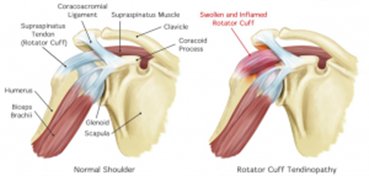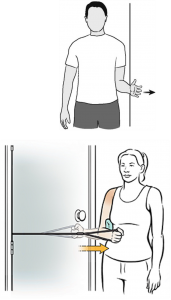By Andrew Citti
Rotator cuff tendinopathy is common amongst the general population as it is seen in about 30% of the overall population and the most common type of shoulder pain. Risk factors include individuals who participate in repetitive overhead activities including repetitive throwing sports like baseball or volleyball or occupations requiring work above shoulder height. Rotator cuff tendinopathy incidence also increases with age and weight as well as muscle imbalances and a reduction in shoulder flexibility.
Function
The rotator cuff is a group of 4 muscles used in a variety of upper extremity movements including flexion, abduction, internal rotation and external rotation.

Strength and flexibility in each of the four muscles is essential for functioning of the entire shoulder girdle.
The rotator cuff keeps the head of the humerus within the small glenoid fossa of the scapula in order to enlarge the range of motion in the glenohumeral (GH) joint.
Presentation
The symptoms of rotator cuff tendinopathy are pain over the front and side of the shoulder joint where the tendons attach to the shoulder. Symptoms are generally pain free at rest and increased with activities such as overhead reaching, reaching behind the back, lifting and sleeping on the affected side. In acute situations, individuals will be unable to reach higher than shoulder height. Pain is generally insidious, occurring due to repetitive activities (often with poor technique) but can also occur suddenly when landing forcefully on an outstretched hand. Associated with shoulder pain is weakness of the rotator cuff and muscles surrounding the shoulder.
Clinical Tests
A physiotherapist will often perform cluster tests to help diagnose whether it is a rotator cuff tendinopathy. A positive test in several of these tests increases the likelihood, these tests on their own do not provide a high level of validity however as a cluster can help diagnose a tendinopathy in the rotator cuff. These tests include:
- Empty can
- Neer’s impingement test
- Hawkins Kennedy
- Painful Arc
Should I get it scanned?
If unsure about the severity or diagnosis, a number of different scans can be used to help identify the cause. A diagnostic ultrasound is the most common to diagnose rotator cuff tendinopathies as well as ruling out partial and full thickness tear. An MRI-scan can also be used to diagnose rotator cuff tendinopathies and partial rotator cuff tears. They will also highlight if surrounding structures such as bursas or ligaments are affected.
Physiotherapy Management
A physiotherapist can use techniques such as massage and dry needling to reduce tightness of muscles surrounding the shoulder to achieve appropriate range of motion. Ice can be used in the early stages to help settle inflammation as well as avoiding aggravating movements. Rest on its own will not improve symptoms, instead it will weaken the muscle and tendon ultimately increasing the recovery. Studies have shown that exercises have improved shoulder function and pain when compared to placebo or control. Finding the right exercises for you is important for getting on track. Isometric and isotonic or two types of exercises which can be used depending on your stage of rehab.
Isometric exercises – Isometric exercise refers to an exercise that uses a static muscle contraction (often performed against a wall as shown in the figure). This means that the muscle group being worked is under tension without the muscle changing length. As a result, the joints involved do not move. Not only do they help strength in the early stages of a tendinopathy they help improve strength and reduce pain inhibition and are a great way to get started in the early stages of rehab.
Isotonic exercises – isotonic exercises refer to exercises working muscle groups through joint movement. These types of exercises are generally prescribed as a progression from isotonic exercises, often towards the middle and end of rehab. Your physiotherapist will often prescribe exercises to improve strength surrounding the whole shoulder complex as well as the rotator cuff. As symptoms reduce and pain improves, exercises will often be progressed by increasing weight and repetition.

Physiotherapy management can vary between individuals based on severity but often recovers within 12 weeks.
Summary
- Rotator cuff is a group of 4 muscles surrounding the shoulder to keep the humerus bone within the small socket
- Rotator cuff tendinopathies are a common injury seen in the general and sporting population with an insidious nature caused by repetitive activities
- Pain is often reported across the front or side of the shoulder triggered by lifting, reaching overhead or behind the back
- Loading the affected tendon has shown to reduce pain and improve function when targeted at the right intensity – see your Physiotherapist for a management plan to get started
